Prevalence of Extended Spectrum Beta-Lactamase Producing Escherichia coli and Klebsiella pneumoniae Isolated from Urinary Tract Infected Patients Attending Tertiary Care Hospital of Central Nepal
DOI:
https://doi.org/10.3126/jcmsn.v15i3.22602Keywords:
E. coli, extended spectrum beta-lactimase, K. pneumoniae, urinary tract infectionAbstract
Background: Urinary tract infection (UTI) is one of the major health problems in Nepal. Escherichia coli (E. coli) and Klebsiella pneumoniae (K. pneumoniae) are two important bacteria associated with UTI. This study was designed to assess the prevalence of extended spectrum beta-lactamase (ESBL) producing E. coli and K. pneumoniae in urinary isolates at College of Medical Sciences and Teaching Hospital, Bharatpur, Chitwan, Nepal.
Methods: We aseptically received 5564 mid-stream urine samples of suspected UTI patients from September 2016 to August 2018. The randomly collected 5564 urine samples were processed by standard Microbiological guidelines as recommended by Clinical and Laboratory Standards Institute (CLSI). All isolates including E. coli and K. pneumoniae were identified using the specific biochemical and sugar fermentation tests. Antibiotic sensitivity test was performed for all the isolates against all commonly used antibiotics by modified Kirby-Bauer disk diffusion method and interpreted following CLSI guidelines. First performed initial screening method then confirmed for ESBL production by phenotypic confirmatory disc diffusion test (PCDDT).
Results: Out of 5,564 urine specimens investigated, E. coli was isolated in 1219 (63.99%) and K. pneumoniae in 223 (11.70%) cases. Initial screening revealed 615 (50.45%) isolates of E. coli and 127 (56.95%) K. pneumoniae to be resistant. Further testing by PCDDT method confirmed 102 (16.58%) E. coli and 25 (19.68%) K. pneumoniae isolates to be ESBL producers. These ESBL producers’ uropathogens revealed high degree of resistance to cephalosporins (100%) and quinolones (52%-92%) group of antibiotics.
Conclusions: In our study the prevalence of ESBL producing K. pneumoniae was found to be 19.68%, those of E. coli was to be 16.58% by PCDDT. In this study, all ESBL producing K. pneumoniae isolates were sensitive (100%) to meropenem and E. coli showed 98.04% sensitive to meropenem. Hence, for the treatment of these ESBL infections, currently, carbapenems are the recommended drug of choice.
Downloads
Downloads
Published
How to Cite
Issue
Section
License
This license enables reusers to copy and distribute the material in any medium or format in unadapted form only, for noncommercial purposes only, and only so long as attribution is given to the creator.




